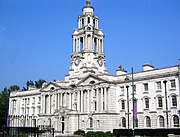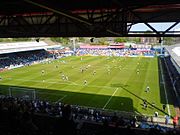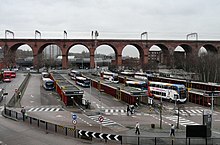Stockport
| Stockport | ||
|---|---|---|
| Stockport Town Hall | ||
| Coordinates | 53 ° 24 ′ N , 2 ° 9 ′ W | |
|
|
||
| Residents | 137,130 (as of 2011) | |
| administration | ||
| Post town | STOCKPORT | |
| ZIP code section | SK1-SK8, SK12 | |
| prefix | 0161 | |
| Part of the country | England | |
| region | North West England | |
| Metropolitan county | Greater Manchester | |
| Metropolitan Borough | Stockport | |
| British Parliament | Stockport | |
| Website: http://www.stockport.gov.uk | ||
Stockport is a city in the English Metropolitan County of Greater Manchester and the administrative seat of the Metropolitan Borough of Stockport of the same name . In 2011 the city had 137,130 inhabitants.
geography
Stockport is located exactly 253 kilometers northwest of London and about ten kilometers southeast of Manchester city center. This is where the River Goyt and River Tame merge and flow into the River Mersey .
history
Name origin
Stockport was first mentioned as a Stokeport in 1170 . The term comes from the Old English language : stoc means market place, and port means something like a hamlet; But stock also means something like fenced area or castle, which refers to Stockport Castle , first mentioned in 1173 .
Early history
The earliest traces of human settlement in the area are microliths of hunters and gatherers from the Mesolithic (8000–3500 BC) and weapons and tools from the Neolithic (3500–2000 BC). Traces from the Bronze Age (2000–1200 BC) are stone hammers, flints and hatchets - all of the items were found by chance. More recent finds date from Roman times (from 70 BC), which indicates an era of depopulation in the previous period. There is vague evidence of a Roman military post at Stockport. It is believed that two Roman roads from Cheadle to Ardotalia and from Manchester to Buxton crossed near the city . A first settlement emerged at a ford over the River Mersey, which was created in the 18th century. Roman origins of Stockport could not be proven; it is not certain that the foundations and building remains from ancient times were connected to the development of a fortified place. Pottery products and a coin store from the fourth century were also discovered from that time. In addition, six coins from the Anglo-Saxon period were discovered.
middle Ages
In the Domesday Book of 1086, Stockport was not mentioned.
Stockport Castle, which was built as a rebel stronghold against the then King Henry II , was first mentioned in 1173 ; their size is estimated at 31 × 60 m. During the 16th and 17th centuries the complex fell into disrepair and was demolished in 1642.
industrialization
Stockport was one of the first cities in Great Britain to develop the textile industry . Since England could not produce its own silk in the 18th century , it had to be imported from Italy. In 1717 John Lombe explored production technology in Italy and copied it when he set up his first textile factory in Derby . When he wanted to renew his patent in 1732, other manufacturers successfully petitioned the government to invalidate the patent. After Lombe had received financial compensation, the first water mill in England for the production of textiles was built on the River Mersey. The industry expanded until 1769 when 2000 people were employed in textile production. Probably because of cheaper imports, the upswing was over by 1772 at the latest.
At the beginning of the 19th century hat making also developed; At the end of the same century, the company switched from manual to mechanical production. In addition to the textile industry, this branch became one of Stockport's largest employers. In addition, supplier trades such as the leather industry and tailoring developed. The First World War cut off the overseas import markets, which hit Stockport's supply-dependent industry considerably. The hat-making industry experienced a second boom in the late 1920s, when around 3,000 people were employed in Stockport. The Great Depression of 1929 abruptly ended this boom too. In addition, the demand for hats decreased in the following years. In 1966/67 the hat makers in Great Britain merged to form a community, the Associated British Hat Manufacturers . At that time there were only two hat factories in Stockport, until the last one had to close in 1997. This marked the end of an era of hat making in the area that had lasted over 400 years. Today the island's only hatter museum in Stockport commemorates that past.
In 1844, Friedrich Engels , philosopher and entrepreneur in the textile industry, visited the city and found that Stockport was "one of the darkest, smokiest holes in the whole industrial region".
Since the 20th century
On November 30, 1948, two trains collided on the ruling Stockport railway viaduct , destroying three cars and killing four people. The rescue measures were made more difficult by the fact that both trains were on a bridge about 30 meters above the ground. According to the BBC, the "thickest fog in years" was one of the causes of the accident.
On June 4, 1967, the Stockport plane crash occurred in which a British Midland Airways plane crashed on its second attempt to land at Manchester Airport near Stockport city center, killing 72 passengers. Only twelve people could be rescued from the burning wreck.
Population development
| Stockport in comparison | |||
|---|---|---|---|
| 2001 census | Stockport | Stockport MB | England |
| Total number of residents |
136.082 | 284,528 | 49.138.831 |
| white | 95.5% | 95.7% | 91% |
| Asians | 2.0% | 2.1% | 4.6% |
| black | 0.5% | 0.4% | 2.3% |
| Christians | 74.9% | 75.4% | 72% |
| Muslims | 1.8% | 1.8% | 3.1% |
| no religion | 15.3% | 14.2% | 15% |
According to the 2001 census, Stockport had 136,082 residents. The population density was 4,613 inh / km² (11,937 mi² ), 94 men per 100 women. Of all persons at least 16 years old, 32% were single and 50.2% were married. In 2001 there were a total of 58,687 households in Stockport, 33.1% of which were owned by one person; 33.7% of all households belonged to married couples, 9.7% belonged to unmarried couples and 10.4% of all households belonged to single parents with child (ren). The numbers correspond roughly to those of the Metropolitan Borough and England. 29.2% of all people aged 16 to 74 did not have a university degree.
While neighborhoods such as Woodford , Bramhall and Hazel Grove are among the wealthiest areas in Britain and 45% of the urban area is green, other areas such as Adswood and Brinnington are suffering from poverty and post-industrial decline. In the northwest of the urban area are the relatively affluent districts of Heaton Moor , Heaton Mersey , Heaton Chapel and Heaton Norris , which together form the so-called Four Heatons .
| Population development in Stockport since 1901 | ||||||||||||
|---|---|---|---|---|---|---|---|---|---|---|---|---|
| year | 1901 | 1911 | 1921 | 1931 | 1939 | 1951 | 1961 | 1971 | 1981 | 1991 | 2001 | 2011 |
| Residents | 92,832 | 108,682 | 123.309 | 125,490 | 134.132 | 141,650 | 142,543 | 139,598 | 136,792 | 132.813 | 136.082 | 137.130 |
| County Borough 1901-1971 | ||||||||||||
politics
The Municipal Corporations Act 1835 introduced a Borough Stockport for the first time, the council of which consisted of 42 MPs and 14 superordinate, so-called aldermen . In 1888 the status of the borough was raised to the county borough . According to the plans of the Local Government Act 1972 , the area merged with surrounding districts to form what is now Metropolitan Borough Stockport within Metropolitan County Greater Manchester .
In 1986 the Greater Manchester County Council was dissolved and many of its functions were transferred to the Council of the Metropolitan Borough Stockport, making it a Unitary Authority .
Town twinning
Stockport maintains city partnerships with Béziers in France and Heilbronn in Germany.
Culture and sights
- Stockport is home to the UK's only millinery museum. It is located in an old hat factory in the Wellington Mill neighborhood, which flourished during the Victorian Age .
- The town hall was opened by the Prince of Wales in 1908 .
- Stockport Air Raid Shelters , a tunnel system that served as an air raid shelter during World War II , is now a museum.
- Vernon Park is just east of the city center. It was created on the fourth anniversary of the Battle of the Alma (September 20, 1858) and was named after Lord Vernon, who made the site available to the city.
- St Elisabeth's Church , built in 1883, is an Anglo-Catholic church .
- The St Mary's Church has a oratory to the twelfth century, the sanctuary comes from a built in 1310. Church. Most of the rest of the building was built in 1813-1817 by the architect Lewis Wyatt. Today it is listed as a Grade I listed building .
- The Plaza Cinema is a cinema built in 1932 and is now a Grade II listed building . Today it shows various film classics as well as live performances.
- The Stockport Viaduct , built in 1840, is one of the largest brick structures in Western Europe and a pioneering achievement in Victorian architecture. A four-track line runs on the 34 m high viaduct from Stockport station to neighboring Manchester. The Grade II listed building cost £ 70,000 to build ; the building consists of around eleven million bricks.
- The Staircase House is a ( Grade II listed ) medieval town house located on the market square. Although it has been renewed several times in the course of its existence, it is probably the oldest secular building in the city. The building now houses the Stockport Story Museum , which claims to tell over 10,000 years of Stockport's history.
- There is also another Grade II listed building, a half-timbered house called Underbank Hall . It was privately owned until 1823, later it became a bank branch.
See also
- Stockport Air Raid Shelters , a facility to protect against air raids during World War II .
Sports
Stockport is home to two professional clubs, both of which have Edgeley Park as their home ground . The Stockport County football club currently plays in the fourth-rate Football League Two . The club was founded in 1883 under the name Heaton Norris Rovers and was given its current name in 1890 to reflect Stockport's new status as a county borough. In the late 1990s, the club expressed interest in moving to Maine Road Stadium , which was previously the home ground of Manchester City . In the end, however, it did not come to that.
The other club that uses Edgeley Park as a venue is the rugby union club Sale Sharks . He won the 2006 Guinness Premiership title ; several national players such as Mark Cueto , Charlie Hodgson and Andrew Sheridan (England) as well as Jason White (Scotland) are employed here.
The Stockport Metro Swimming Club is one of the UK's most successful swimming clubs. In the 1996 Olympics whose swimmers won Graeme Smith bronze in the 1500m freestyle , and in 2004 won Stephen Parry bronze in the 200m butterfly . Most recently, at the 2008 Beijing Games , Keri-Anne Payne and Cassie Patten won silver and bronze, respectively, in the 10 km long-distance swimming .
Stockport is a center of British lacrosse . The Stockport Lacrosse Club was founded in 1876, making it one of the oldest lacrosse clubs in the world. Other clubs exist in Norbury (Hazel Grove) Cheadle, Cheadle Hulme, Heaton Mersey, Heaton Mersey Guild, and Mellor. In 1978 Edgeley Park hosted the Lacrosse World Championship .
Stockport owns three athletics clubs: Manchester Harriers & AC, Stockport Harriers & AC, and DASH Athletics Club.
Stockport is the birthplace of tennis player Fred Perry , who won both Wimbledon and the US Open in 1936.
Economy and Infrastructure
traffic
The M60 , the motorway ring of Manchester, runs through the urban area of Stockport . In the far west, the M56 branches off towards Chester . In addition, the borough is crossed by the national A-roads A6 ( Luton - Carlisle ) and A34 (Manchester - Winchester ). Other A-roads are the A555, A560, A626, A5102, A5143 and the A5149.
The Stockport Edgeley station is located on a bypass of the West Coast Main Line , which the main railway station Manchester, Piccadilly operated. Virgin Trains offers a service to London , Euston , every 20 minutes on the route , with two trains per hour passing through Stoke-on-Trent and one through Crewe . In a north-westerly direction you can reach the cities of Liverpool , Preston , Blackpool , Wigan , Southport and Barrow-in-Furness directly (via Manchester) . To the southeast there are connections (via Sheffield ) to Cleethorpes , Nottingham and Norwich . Regional trains run on the Mid-Cheshire Line from Manchester via Stockport, Altrincham , Knutsford and Northwich to Chester. Regular passenger traffic on the Stockport – Stalybridge railway was discontinued in the early 1990s. A second station called Stockport Tiviot Dale was in operation from 1865 to 1967. The station area was then built over by the new M60 motorway ring.
The construction of the railway viaduct over the Mersey, at that time the largest viaduct in the world, is considered a pioneering achievement ; it was completed in 1840 and has been connecting Stockport with Manchester ever since.
Manchester Airport is located just west of Stockport and can be reached by train and car.
education
Stockport's largest educational institution is Stockport College with approximately 11,000 students. The Stockport Grammar School is the oldest in the north of England, it was founded in 1487.
For the other schools see the English language Wikipedia.
Personalities
Honorary citizen
- Manfred Weinmann (1934–2013), Lord Mayor of Heilbronn
sons and daughters of the town
- George Back (1796–1878), navigator
- Joseph Whitworth (1803-1887), engineer
- Isaac Watt Boulton (1823-1899), engineer
- Charles Webster Leadbeater (1847–1934), priest, theosophist and occultist
- Horace Lamb (1849–1934), mathematician and physicist
- Clifford Hugh Douglas (1879–1952), engineer
- William Garbutt (1883–1964), football player and coach
- Fred Perry (1909–1995), table tennis player, tennis player and fashion designer
- Walter Herrenbrück senior (1910–1978), German theologian and state superintendent of northwest Germany
- Frederic Calland Williams (1911–1977), engineer
- Ted Allbeury (1917-2005), author
- Margaret Burbidge (1919–2020), American astrophysicist of British origin
- Brian Rawlinson (1931-2000), actor
- Alfred Lomas (* 1928), politician
- Norman Foster (* 1935), architect, designer and winner of the Pritzker Prize
- Sabrina (1936–2016), actress and sex symbol
- Peter Snape (born 1942), politician
- John Goto (born 1949), artist
- Peter Boardman (1950–1982), mountaineer, Everest climber and author
- Geoff Downes (* 1952), rock keyboardist
- Paul Morley (* 1957), music journalist and producer
- Dave Ridgway (* 1959), English-Canadian football player
- Tony O'Shea (born 1961), darts player
- Steve Thomas (* 1963), ice hockey player and coach
- Mark Gillespie (* 1970), guitarist and singer
- Wayne McGregor (* 1970), choreographer
- Simon Stephens (* 1971), playwright
- Anthony Kappes (* 1973), cyclist
- Paul Manning (* 1974), racing cyclist
- Daz Sampson (* 1974), music producer and singer
- Dominic Howard (* 1977), drummer for the rock band Muse
- Danny Pugh (born 1982), football player
- Tyrone Mears (born 1983), soccer player
- Kelly Wenham (born 1983), actress
- Claire Foy (* 1984), actress
- Ryan Crowther (born 1988), football player
- Nathan Aspinall (* 1991), darts player
- Michael Keane (* 1993), soccer player
- Phil Foden (* 2000), soccer player
Web links
- The City website (English)
Individual evidence
- ^ Accident at Stockport on November 30th, 1948. In: The Railways Archive. Retrieved March 31, 2018 (UK English).
- ^ List of schools in Stockport in the English language Wikipedia






